You have an Azure subscription.
You have an on-premises virtual machine named VM1. The settings for VM1 are shown in the exhibit. (Click the Exhibit tab.)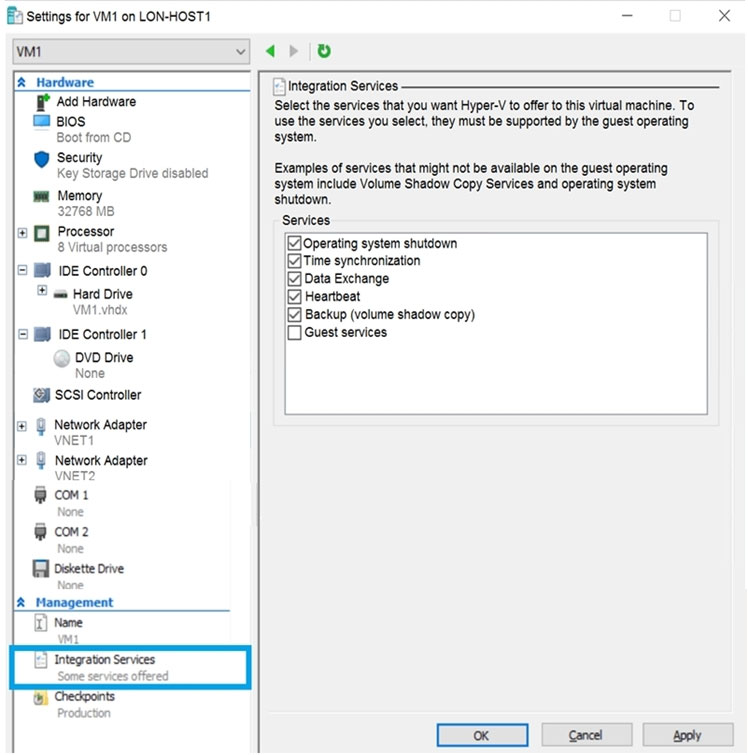
You need to ensure that you can use the disks attached to VM1 as a template for Azure virtual machines.
What should you modify on VM1?
- A. the memory
- B. Integration Services
- C. the hard drive
- D. the network adapters
Correct Answer: C
From the exhibit we see that the disk is in the VHDX format.
Before you upload a Windows virtual machines (VM) from on-premises to Microsoft Azure, you must prepare the virtual hard disk (VHD or VHDX). Azure supports only generation 1 VMs that are in the VHD file format and have a fixed sized disk. The maximum size allowed for the VHD is 1,023 GB. You can convert a generation 1 VM from the VHDX file system to VHD and from a dynamically expanding disk to fixed-sized.
Reference:
https://docs.microsoft.com/en-us/azure/virtual-machines/windows/prepare-for-upload-vhd-image?toc=azure virtual-machines windows toc.json
Your company has an office in Seattle.
You have an Azure subscription that contains a virtual network named VNET1.
You create a site-to-site VPN between the Seattle office and VNET1.
VNET1 contains the subnets shown in the following table.
You need to route all Internet-bound traffic from Subnet1 to the Seattle office.
What should you create?
- A. a route for GatewaySubnet that uses the virtual network gateway as the next hop
- B. a route for Subnet1 that uses the local network gateway as the next hop
- C. a route for Subnet1 that uses the virtual network gateway as the next hop
- D. a route for GatewaySubnet that uses the local network gateway as the next hop
Correct Answer: C
A route with the 0.0.0.0/0 address prefix instructs Azure how to route traffic destined for an IP address that is not within the address prefix of any other route in a subnet's route table. When a subnet is created, Azure creates a default route to the 0.0.0.0/0 address prefix, with the Internet next hop type. We need to create a custom route in Azure to use a virtual network gateway in the Seattle office as the next hop.
Reference:
https://docs.microsoft.com/en-us/azure/virtual-network/virtual-networks-udr-overview
HOTSPOT -
You have Azure Storage accounts as shown in the following exhibit.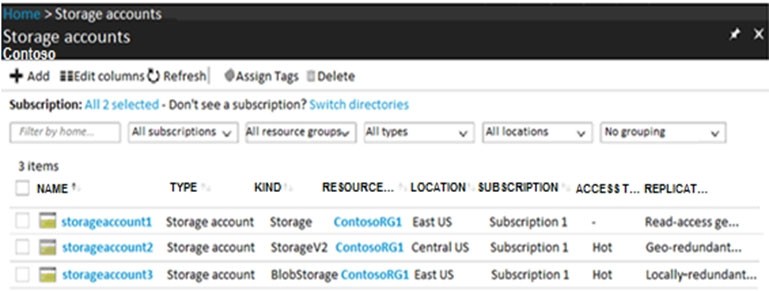
Use the drop-down menus to select the answer choice that completes each statement based on the information presented in the graphic.
NOTE: Each correct selection is worth one point.
Hot Area: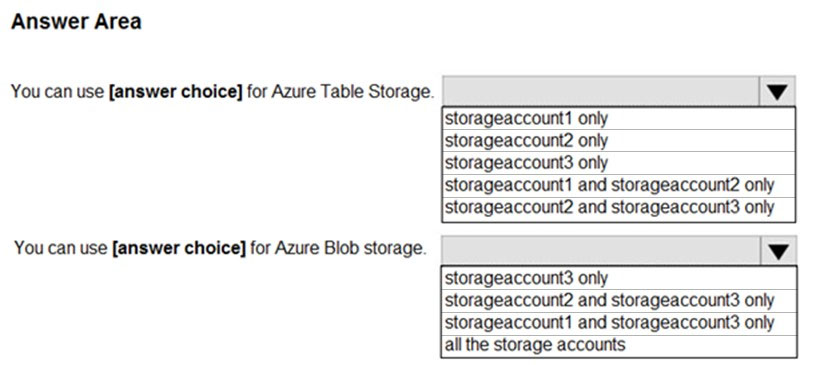
Correct Answer: 
Box 1: storageaccount1 and storageaccount2 only
Box 2: All the storage accounts -
Note: The three different storage account options are: General-purpose v2 (GPv2) accounts, General-purpose v1 (GPv1) accounts, and Blob storage accounts.
✑ General-purpose v2 (GPv2) accounts are storage accounts that support all of the latest features for blobs, files, queues, and tables.
✑ Blob storage accounts support all the same block blob features as GPv2, but are limited to supporting only block blobs.
✑ General-purpose v1 (GPv1) accounts provide access to all Azure Storage services, but may not have the latest features or the lowest per gigabyte pricing.
Reference:
https://docs.microsoft.com/en-us/azure/storage/common/storage-account-options
You create an Azure virtual machine named VM1 in a resource group named RG1.
You discover that VM1 performs slower than expected.
You need to capture a network trace on VM1.
What should you do?
- A. From the VM1 blade, configure Connection troubleshoot.
- B. From Diagnostic settings for VM1, configure the performance counters to include network counters.
- C. From the VM1 blade, install performance diagnostics and run advanced performance analysis.
- D. From Diagnostic settings for VM1, configure the log level of the diagnostic agent.
Correct Answer: C
The performance diagnostics tool helps you troubleshoot performance issues that can affect a Windows or Linux virtual machine (VM). Supported troubleshooting scenarios include quick checks on known issues and best practices, and complex problems that involve slow VM performance or high usage of CPU, disk space, or memory.
Advanced performance analysis, included in the performance diagnostics tool, includes all checks in the performance analysis, and collects one or more of the traces, as listed in the following sections. Use this scenario to troubleshoot complex issues that require additional traces. Running this scenario for longer periods will increase the overall size of diagnostics output, depending on the size of the VM and the trace options that are selected.
Reference:
https://docs.microsoft.com/en-us/azure/virtual-machines/troubleshooting/performance-diagnostics
You have an Azure subscription named Subscription1 that contains an Azure virtual network named VNet1. VNet1 connects to your on-premises network by using
Azure ExpressRoute.
You need to connect VNet1 to the on-premises network by using a site-to-site VPN. The solution must minimize cost.
Which three actions should you perform? Each correct answer presents part of the solution.
NOTE: Each correct selection is worth one point.
- A. Create a gateway subnet.
- B. Create a VPN gateway that uses the VpnGw1 SKU.
- C. Create a connection.
- D. Create a local site VPN gateway.
- E. Create a VPN gateway that uses the Basic SKU.
Correct Answer: CDE
Reference:
https://docs.microsoft.com/en-za/archive/blogs/canitpro/step-by-step-configuring-a-site-to-site-vpn-gateway-between-azure-and-on-premise
Your network contains an on-premises Active Directory domain named contoso.com. The domain contains the users shown in the following table.
You plan to install Azure AD Connect and enable SSO.
You need to specify which user to use to enable SSO. The solution must use the principle of least privilege.
Which user should you specify?
- A. User3
- B. User2
- C. User1
- D. User4
Correct Answer: C
You need to have domain administrator credentials for each Active Directory forest that:
✑ You synchronize to Azure AD through Azure AD Connect.
✑ Contains users you want to enable for Seamless SSO.
Note: The domain administrator credentials are not stored in Azure AD Connect or in Azure AD. They're used only to enable Seamless SSO through Azure AD
Connect.
Reference:
https://docs.microsoft.com/en-us/azure/active-directory/hybrid/how-to-connect-sso-quick-start
HOTSPOT -
You have an Azure subscription that contains the resource groups shown in the following table.
RG1 contains the virtual machines shown in the following table.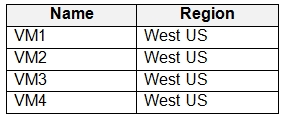
RG2 contains the virtual machines shown in the following table.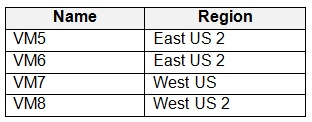
All the virtual machines are configured to use premium disks and are accessible from the Internet.
VM1 and VM2 are in an availability set named AVSET1. VM3 and VM4 are in the same availability zone. VM5 and VM6 are in different availability zones.
For each of the following statements, select Yes if the statement is true. Otherwise, select No.
NOTE: Each correct selection is worth one point.
Hot Area: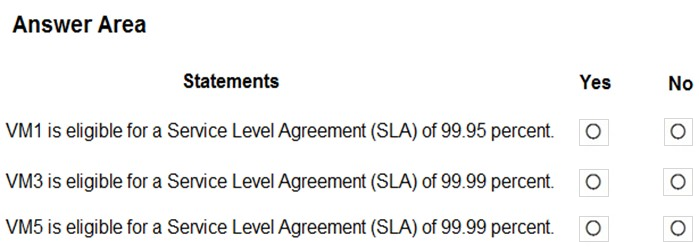
Correct Answer: 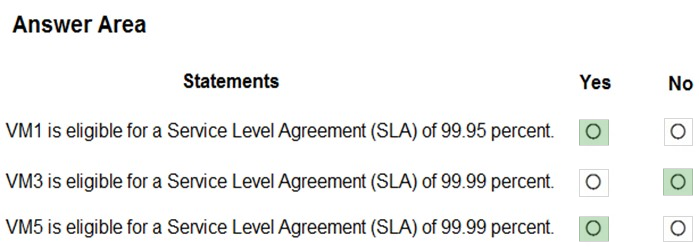
Box 1: Yes -
VM1 and VM2 are in an available set named AVSET1.
For all Virtual Machines that have two or more instances deployed in the same Availability Set, we [Microsoft] guarantee you will have Virtual Machine Connectivity to at least one instance at least 99.95% of the time.
Box 2: No -
VM3 and VM4 are in the same availability zone and are in an availability set named AVSET2.
Box 3: Yes -
VM5 and VM6 are in different availability zones.
For all Virtual Machines that have two or more instances deployed across two or more Availability Zones in the same Azure region, we [Microsoft] guarantee you will have Virtual Machine Connectivity to at least one instance at least 99.99% of the time.
Reference:
https://azure.microsoft.com/en-us/support/legal/sla/virtual-machines/v1_8/
A company plans to use third-party application software to perform complex data analysis processes. The software will use up to 500 identical virtual machines
(VMs) based on an Azure Marketplace VM image.
You need to design the infrastructure for the third-party application server. The solution must meet the following requirements:
✑ The number of VMs that are running at any given point in time must change when the user workload changes.
✑ When a new version of the application is available in Azure Marketplace it must be deployed without causing application downtime.
✑ Use VM scale sets.
✑ Minimize the need for ongoing maintenance.
Which two technologies should you recommend? Each correct answer presents part of the solution.
NOTE: Each correct selection is worth one point.
- A. single placement group
- B. single storage account
- C. managed disks
- D. autoscale
Correct Answer: CD
You have a resource group named RG1 that contains the following:
✑ A virtual network that contains two subnets named Subnet1 and AzureFirewallSubnet
✑ An Azure Storage account named contososa1
✑ An Azure firewall deployed to AzureFirewallSubnet
You need to ensure that contososa1 is accessible from Subnet1 over the Azure backbone network.
What should you do?
- A. Modify the Firewalls and virtual networks settings for contososa1.
- B. Create a stored access policy for contososa1.
- C. Implement a virtual network service endpoint.
- D. Remove the Azure firewall.
Correct Answer: C
Storage firewall rules apply to the public endpoint of a storage account. You don't need any firewall access rules to allow traffic for private endpoints of a storage account. The process of approving the creation of a private endpoint grants implicit access to traffic from the subnet that hosts the private endpoint.
Note: Storage accounts have a public endpoint that is accessible through the internet. ou can also create Private Endpoints for your storage account, which assigns a private IP address from your VNet to the storage account, and secures all traffic between your VNet and the storage account over a private link. The
Azure storage firewall provides access control access for the public endpoint of your storage account. You can also use the firewall to block all access through the public endpoint when using private endpoints. Your storage firewall configuration also enables select trusted Azure platform services to access the storage account securely.
Reference:
https://docs.microsoft.com/en-us/azure/storage/common/storage-network-security
You have an Azure subscription that contains 100 virtual machines.
You have a set of PowerShell scripts that validate the virtual machine environment.
You need to run the scripts whenever there is an operating system update on the virtual machines. The solution must minimize implementation time and recurring costs.
Which three resources should you use to implement the scripts? Each correct answer presents part of the solution.
NOTE: Each correct selection is worth one point.
- A. an alert action group
- B. an Azure Monitor query
- C. an Azure Automation runbook
- D. a virtual machine that has network access to the 100 virtual machines
- E. an alert rule
Correct Answer: ACE
E: Step 1: Create alert -
In your Automation account, select Alerts under Monitoring, and then select New alert rule.
A: Step 2: Configure action groups for your alerts
Once you have your alerts configured, you can set up an action group, which is a group of actions to use across multiple alerts. The actions can include email notifications, runbooks, webhooks, and much more.
C: Use a Azure Automation runbook to run the powershell scipts.
Note: The Azure Automation Process Automation feature supports several types of runbooks, such as the PowerShell runbook, which is a text runbook based on
Windows PowerShell.scripting.
Reference:
https://docs.microsoft.com/en-us/azure/automation/update-management/configure-alerts https://docs.microsoft.com/en-us/azure/automation/automation-runbook-types
You have an Active Directory forest named contoso.com.
You install and configure Azure AD Connect to use password hash synchronization as the single sign-on (SSO) method. Staging mode is enabled.
You review the synchronization results and discover that the Synchronization Service Manager does not display any sync jobs.
You need to ensure that the synchronization completes successfully.
What should you do?
- A. Run Azure AD Connect and disable staging mode.
- B. From Synchronization Service Manager, run a full import.
- C. Run Azure AD Connect and set the SSO method to Pass-through Authentication.
- D. From Azure PowerShell, run Start-AdSyncSyncCycle ""PolicyType Initial.
Correct Answer: A
In staging mode, the server is active for import and synchronization, but it does not run any exports. A server in staging mode is not running password sync or password writeback, even if you selected these features during installation. When you disable staging mode, the server starts exporting, enables password sync, and enables password writeback.
Reference:
https://docs.microsoft.com/en-us/azure/active-directory/hybrid/how-to-connect-sync-staging-server https://docs.microsoft.com/en-us/azure/active-directory/hybrid/how-to-connect-sync-operations
Your on-premises network contains 100 virtual machines that run Windows Server 2019.
You have an Azure subscription that contains an Azure Log Analytics workspace named Workspace1.
You need to collect errors from the Windows event logs on the virtual machines.
Which two actions should you perform? Each correct answer presents part of the solution.
NOTE: Each correct selection is worth one point.
- A. Create an Azure Event Grid domain.
- B. Deploy the Microsoft Monitoring Agent.
- C. Configure Windows Event Forwarding on the virtual machines.
- D. Create an Azure Sentinel workspace.
- E. Configure the Data Collection settings for Workspace1.
Correct Answer: BE
The Azure Log Analytics agent collects telemetry from Windows and Linux virtual machines in any cloud, on-premises machines, and those monitored by System
Center Operations Manager and sends it collected data to your Log Analytics workspace in Azure Monitor.
Note: You may also see the Log Analytics agent referred to as the Microsoft Monitoring Agent (MMA) or OMS Linux agent.
Data is collected using the Log Analytics agent, which reads various security-related configurations and event logs from the machine and copies the data to your workspace for analysis.
Reference:
https://docs.microsoft.com/en-us/azure/azure-monitor/platform/log-analytics-agent https://docs.microsoft.com/en-us/azure/security-center/security-center-enable-data-collection
You have an Azure subscription named Subscription1.
You deploy a Linux virtual machine named VM1 to Subscription1.
You need to monitor the metrics and the logs of VM1.
What should you use?
- A. Azure HDInsight
- B. Azure Analysis Services
- C. Linux Diagnostic Extension (LAD) 3.0
- D. the AzurePerformanceDiagnostics extension
Correct Answer: D
You can use extensions to configure diagnostics on your VMs to collect additional metric data.
The basic host metrics are available, but to see more granular and VM-specific metrics, you need to install the Azure diagnostics extension on the VM. The Azure diagnostics extension allows additional monitoring and diagnostics data to be retrieved from the VM.
Reference:
https://docs.microsoft.com/en-us/azure/virtual-machines/linux/tutorial-monitoring
HOTSPOT -
You plan to deploy five virtual machines to a virtual network subnet.
Each virtual machine will have a public IP address and a private IP address.
Each virtual machine requires the same inbound and outbound security rules.
What is the minimum number of network interfaces and network security groups that you require? To answer, select the appropriate options in the answer area.
NOTE: Each correct selection is worth one point.
Hot Area: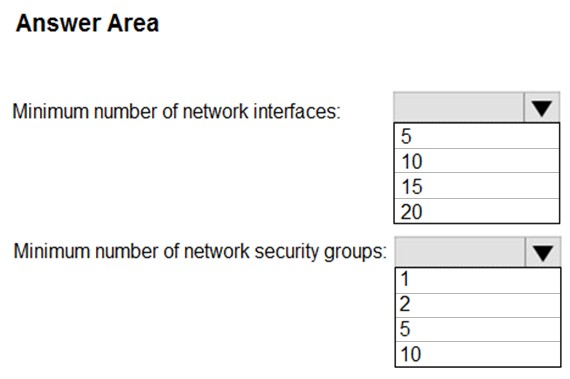
Correct Answer: 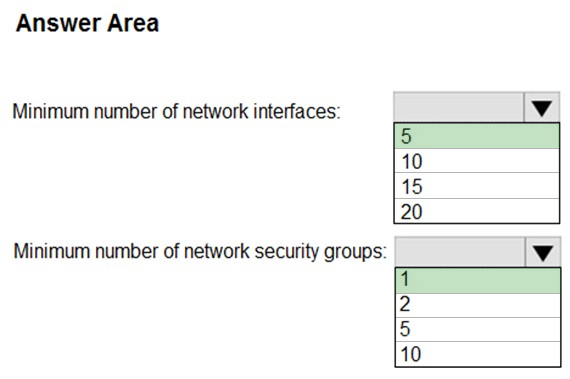
Box 1: 5 -
We have five virtual machines. Each virtual machine will have a public IP address and a private IP address. Each will require a network interface.
Box 2: 1 -
Each virtual machine requires the same inbound and outbound security rules. We can add tem to one group.
Reference:
https://blogs.msdn.microsoft.com/igorpag/2016/05/14/azure-network-security-groups-nsg-best-practices-and-lessons-learned/ https://docs.microsoft.com/en-us/azure/virtual-network/security-overview
You have an Azure subscription named Subscription1 that includes an Azure File share named share1.
You create several Azure virtual machines in Subscription1. All of the virtual machines belong to the same virtual network.
You have an on-premises Hyper-V server named Server1. Server1 hosts a virtual machine named VM1.
You plan to replicate VM1 to Azure.
You need to create additional objects in Subscription1 to support the planned deployment.
Which three objects should you create? Each correct answer presents part of the solution.
NOTE: Each correct selection is worth one point.
- A. Hyper-V site
- B. Azure Recovery Services Vault
- C. storage account
- D. replication policy
- E. Azure Traffic Manager instance
- F. endpoint
Correct Answer: ABD
You manage an Active Directory domain named contoso.local.
You install Azure AD Connect and connect to an Azure Active Directory (Azure AD) tenant named contoso.com without syncing any accounts.
You need to ensure that only users who have a UPN suffix of contoso.com in the contoso.local domain sync to Azure AD.
What should you do?
- A. Use the Synchronization Service Manager to modify the Metaverse Designer tab.
- B. Use Azure AD Connect to customize the synchronization options.
- C. Use the Synchronization Rules Editor to create a synchronization rule.
- D. Use Synchronization Service Manager to modify the Active Directory Domain Services (AD DS) Connector.
Correct Answer: C
Filtering what objects are synced to Azure AD is a common request and there are many instances where filtering by OU just doesn't cut it. One option is to filter users by their UPN suffix so that only users with the public FQDN as their UPN suffix are synced to Azure AD (e.g., john.doe@acme.com would be synced while jane.doe@internal.acme.com would not).
Filtering can be configured using either the GUI or PowerShell.
Through GUI:
Using The Synchronization Rules Editor
1. Open the Synchronization Rules Editor on the server where Azure AD Connect is installed.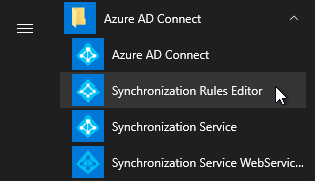
2. Click the Add new rule button on the View and manage your synchronization rules window.
3. Fill out the appropriate fields on the Description tab and click Next >.
4. On the Scoping filter tab, click Add group, then Add clause, add a userPrincipalName attribute filter, and click Next >.
Attribute: userPrincipalName -
Operator: ENDSWITH -
Value: Your internal UPN suffix prefixed with @ (e.g., @internal.acme.com). Users with this UPN suffix will NOT be synced with Office 365.
Reference:
https://www.sidekicktech.com/blog/field-notes/2019/upn-suffix-filtering-ad-connect/
You have an Azure SQL database named DB1.
You plan to create the following four tables in DB1 by using the following code.
Table1.
Table2.
Table3.
Table4.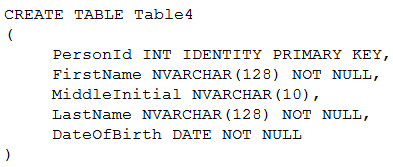
You need to identify which table must be created last.
What should you identify?
- A. Table1
- B. Table2
- C. Table3
- D. Table4
Correct Answer: B
Table1 references Table4. Therefore Table4 must be created before Table1.
Table2 references Table1 and Table3. Therefore Table1 and Table3 must be created before Table2.
Note: FOREIGN KEY REFERENCES is a constraint that provides referential integrity for the data in the column or columns. FOREIGN KEY constraints require that each value in the column exists in the corresponding referenced column or columns in the referenced table. FOREIGN KEY constraints can reference only columns that are PRIMARY KEY or UNIQUE constraints in the referenced table or columns referenced in a UNIQUE INDEX on the referenced table.
Incorrect Answers:
A: Table1 is referenced by Table2 and should be crated before Table2.
C: Table3 is referenced by Table2 and should be crated before Table2.
D: Table4 is referenced by Table1 and should be crated before Table1.
Reference:
https://docs.microsoft.com/en-us/sql/t-sql/statements/create-table-transact-sql?view=sql-server-ver15
You have an Azure Cosmos DB account named Account1. Account1 includes a database named DB1 that contains a container named Container1. The partition key for Container1 is set to /city.
You plan to change the partition key for Container1.
What should you do first?
- A. Delete Container1.
- B. Create a new Azure Cosmos DB account.
- C. Implement the Azure Cosmos DB.NET.SDK.
- D. Regenerate the keys for Account1.
Correct Answer: B
The Change Feed Processor and Bulk Executor Library, in Azure Cosmos DB can be leveraged to achieve a live migration of your data from one container to another. This allows you to re-distribute your data to match the desired new partition key scheme, and make the relevant application changes afterwards, thus achieving the effect of "updating your partition key".
Incorrect Answers:
A: It is not possible to "update" your partition key in an existing container.
Reference:
https://devblogs.microsoft.com/cosmosdb/how-to-change-your-partition-key/
You have an Azure subscription that contains the resource groups shown in the following table.
You have the Azure SQL servers shown in the following table.
You create an Azure SQL database named DB1 on Sql1 in an elastic pool named Pool1.
You need to create an Azure SQL database named DB2 in Pool1.
Where should you deploy DB2?
- A. Sql1
- B. Sql2
- C. Sql3
- D. Sql4
Correct Answer: A
The databases in an elastic pool are on a single Azure SQL Database server and share a set number of resources at a set price.
Reference:
https://docs.microsoft.com/en-us/azure/sql-database/sql-database-elastic-pool
HOTSPOT -
You deploy an Azure virtual machine scale set named VSS1 that contains 30 virtual machine instances across three zones in the same Azure region. The instances host an application named App1 that must be accessible by using HTTP and HTTPS traffic. Currently, VSS1 is inaccessible from the internet.
You need to use Azure Load Balancer to provide access to App1 across all the instances from the internet by using a single IP address.
What should you configure? To answer, select the appropriate options in the answer area.
NOTE: Each correct selection is worth one point.
Hot Area: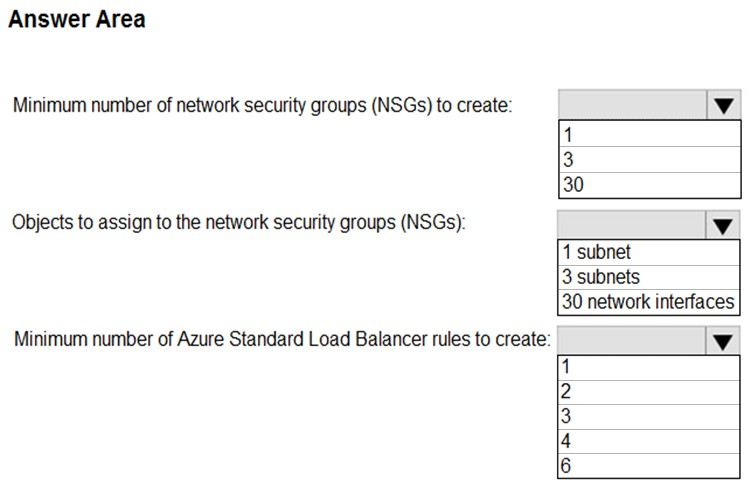
Correct Answer: 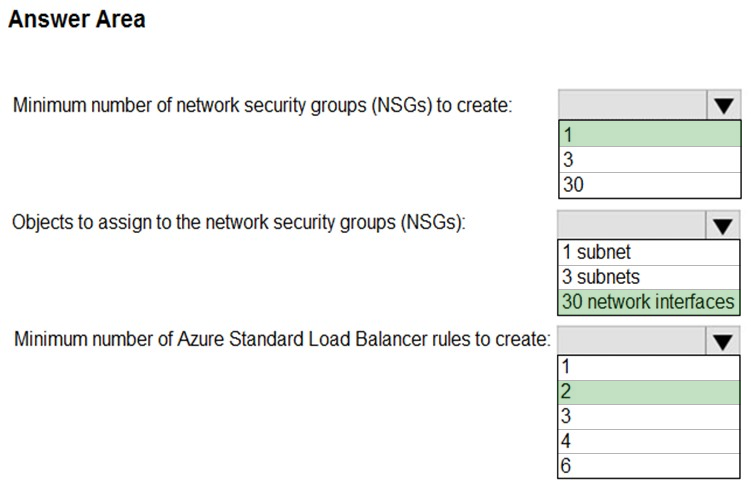
Box 1: 1 -
Box 2: 30 network interfaces -
For a standard load balancer, the VMs in the backend address for are required to have network interfaces that belong to a network security group.
Box 3: 2 -
On for the HTTP traffic, and one for the HTTPs traffic.
Reference:
https://docs.microsoft.com/en-us/azure/load-balancer/quickstart-load-balancer-standard-public-cli
Note: This question is part of a series of questions that present the same scenario. Each question in the series contains a unique solution that might meet the stated goals. Some question sets might have more than one correct solution, while others might not have a correct solution.
After you answer a question in this section, you will NOT be able to return to it. As a result, these questions will not appear in the review screen.
You have an app named App1 that uses data from two on-premises Microsoft SQL Server databases named DB1 and DB2.
You plan to move DB1 and DB2 to Azure.
You need to implement Azure services to host DB1 and DB2. The solution must support server-side transactions across DB1 and DB2.
Solution: You deploy DB1 and DB2 as Azure SQL databases each on a different Azure SQL Database server.
Does this meet the goal?
- A. Yes
- B. No
Correct Answer: B
Instead deploy DB1 and DB2 to SQL Server on an Azure virtual machine.
Note: Understanding distributed transactions.
When both the database management system and client are under the same ownership (e.g. when SQL Server is deployed to a virtual machine), transactions are available and the lock duration can be controlled.
Reference:
https://docs.particular.net/nservicebus/azure/understanding-transactionality-in-azure
Note: This question is part of a series of questions that present the same scenario. Each question in the series contains a unique solution that might meet the stated goals. Some question sets might have more than one correct solution, while others might not have a correct solution.
After you answer a question in this section, you will NOT be able to return to it. As a result, these questions will not appear in the review screen.
You have an app named App1 that uses data from two on-premises Microsoft SQL Server databases named DB1 and DB2.
You plan to move DB1 and DB2 to Azure.
You need to implement Azure services to host DB1 and DB2. The solution must support server-side transactions across DB1 and DB2.
Solution: You deploy DB1 and DB2 as Azure SQL databases on the same Azure SQL Database server.
Does this meet the goal?
- A. Yes
- B. No
Correct Answer: B
Instead deploy DB1 and DB2 to SQL Server on an Azure virtual machine.
Note: Understanding distributed transactions.
When both the database management system and client are under the same ownership (e.g. when SQL Server is deployed to a virtual machine), transactions are available and the lock duration can be controlled.
Reference:
https://docs.particular.net/nservicebus/azure/understanding-transactionality-in-azure
Note: This question is part of a series of questions that present the same scenario. Each question in the series contains a unique solution that might meet the stated goals. Some question sets might have more than one correct solution, while others might not have a correct solution.
After you answer a question in this section, you will NOT be able to return to it. As a result, these questions will not appear in the review screen.
You have an Azure Cosmos DB database that contains a container named Container1. The partition key for Container1 is set to /day. Container1 contains the items shown in the following table.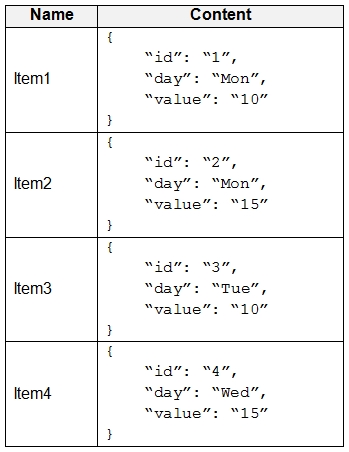
You need to programmatically query Azure Cosmos DB and retrieve Item1 and Item2 only.
Solution: You run the following query.
SELECT day -
WHERE value = "10"
You set the EnableCrossPartitionQuery property to False.
Does this meet the goal?
- A. Yes
- B. No
Correct Answer: B
Returns Item1 only as EnableCrossPartitionQuery property to False. If EnableCrossPartitionQuery property is set to true, it will return Item1 and Item3.
Reference:
https://docs.microsoft.com/en-us/azure/cosmos-db/sql-query-where
HOTSPOT -
You have an on-premises data center and an Azure subscription. The data center contains two VPN devices. The subscription contains an Azure virtual network named VNet1. VNet1 contains a gateway subnet.
You need to create a site-to-site VPN. The solution must ensure that if a single instance of an Azure VPN gateway fails, or a single on-premises VPN device fails, the failure will not cause an interruption that is longer than two minutes.
What is the minimum number of public IP addresses, virtual network gateways, and local network gateways required in Azure? To answer, select the appropriate options in the answer area.
NOTE: Each correct selection is worth one point.
Hot Area: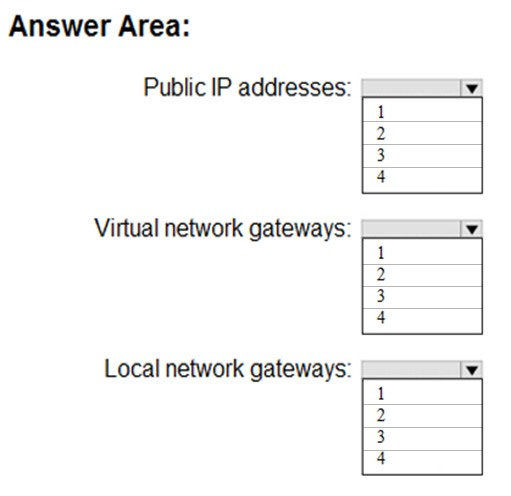
Correct Answer: 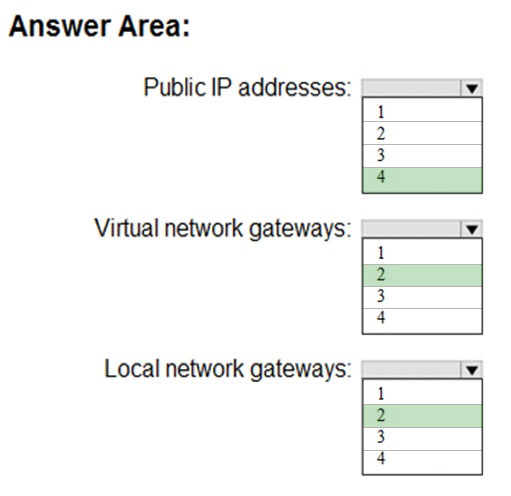
Box 1: 4 -
Two public IP addresses in the on-premises data center, and two public IP addresses in the VNET.
The most reliable option is to combine the active-active gateways on both your network and Azure, as shown in the diagram below.
Box 2: 2 -
Every Azure VPN gateway consists of two instances in an active-standby configuration. For any planned maintenance or unplanned disruption that happens to the active instance, the standby instance would take over (failover) automatically, and resume the S2S VPN or VNet-to-VNet connections.
Box 3: 2 -
Dual-redundancy: active-active VPN gateways for both Azure and on-premises networks
Reference:
https://docs.microsoft.com/en-us/azure/vpn-gateway/vpn-gateway-highlyavailable
You have an Azure subscription that contains an Azure Sentinel workspace. Sentinel is configured to monitor several Azure resources.
You need to send notification emails to resource owners when alerts or recommendations are generated for a resource.
What should you use?
- A. Logic Apps Designer
- B. Azure Security Center
- C. Azure Pipelines
- D. Azure Machine Learning Studio
Correct Answer: A
Currently there is no built-in functionality that notifies you via email if there is an incident that is generated in Azure Sentinel. However, you can set up an Azure
Logic App playbook to send incident information to your email.
Reference:
https://azsec.azurewebsites.net/2020/01/19/notify-azure-sentinel-alert-to-your-email-automatically/
Implement and Monitor an Azure Infrastructure
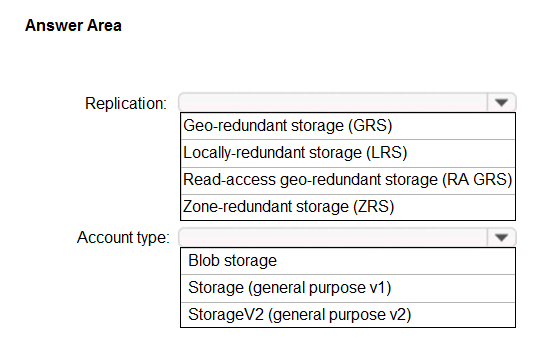
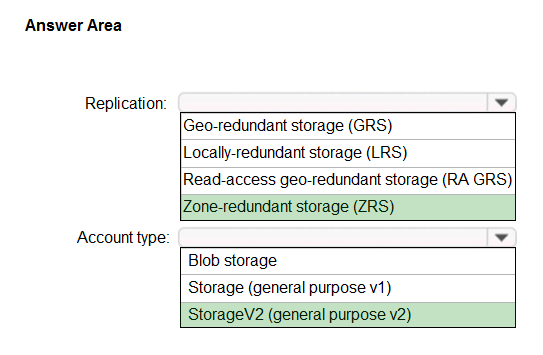
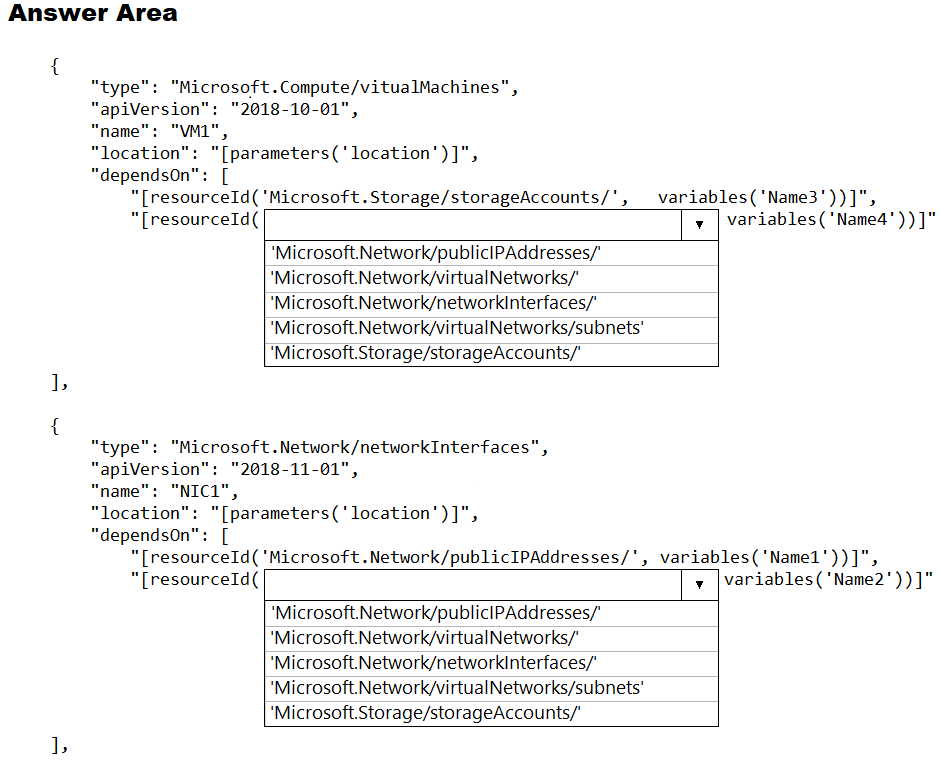
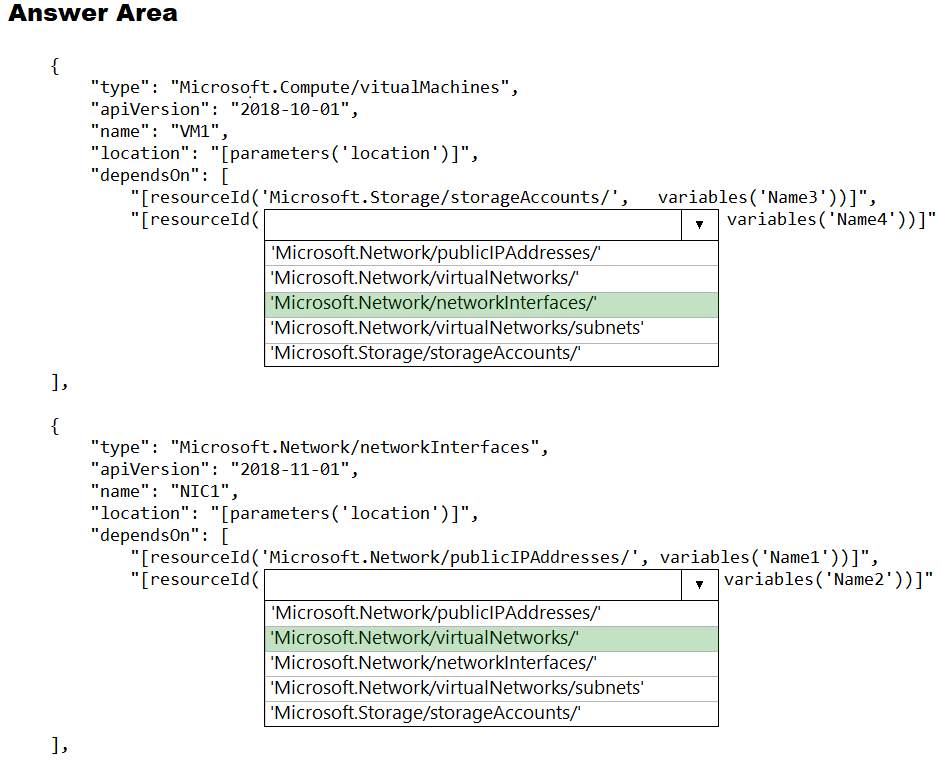
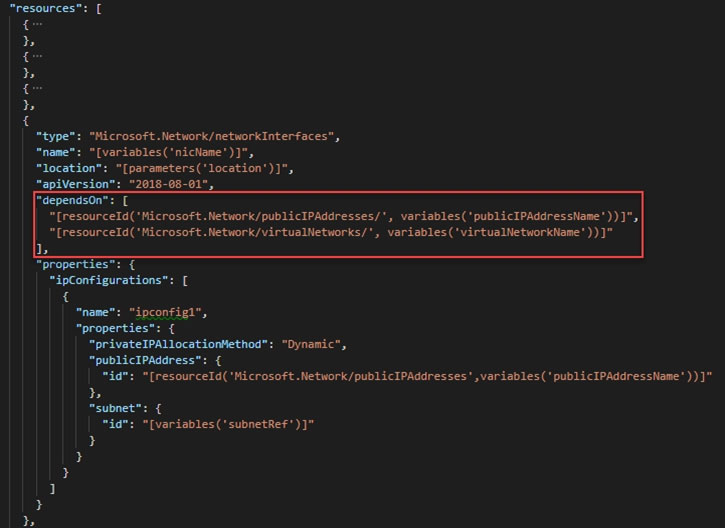
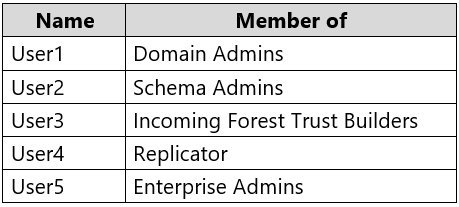
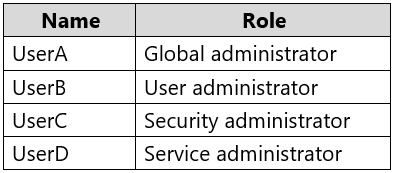
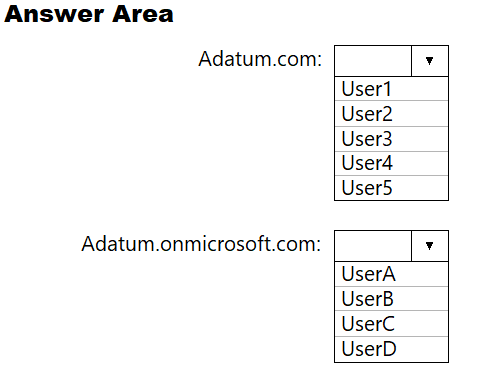

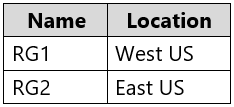
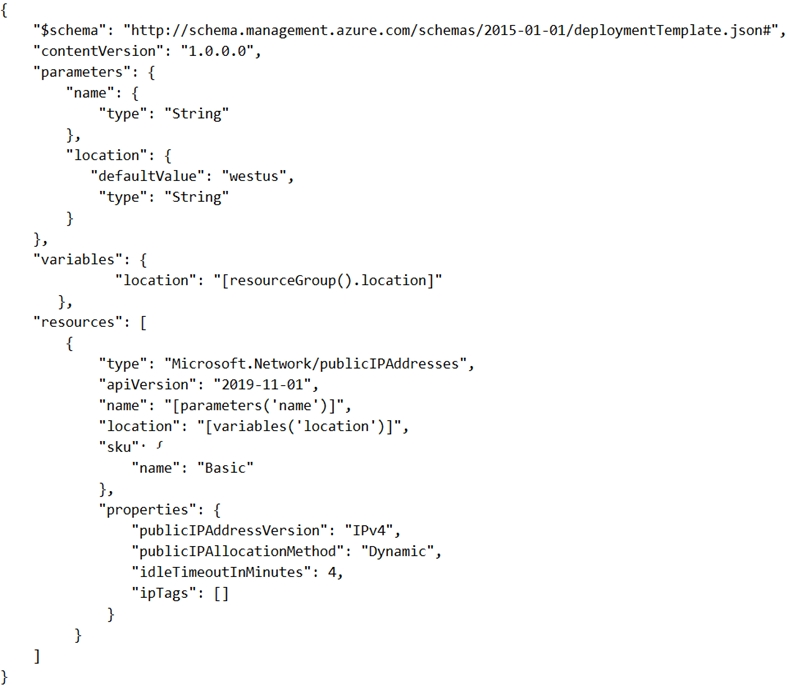
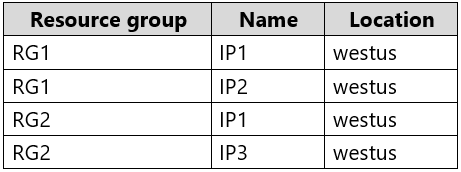
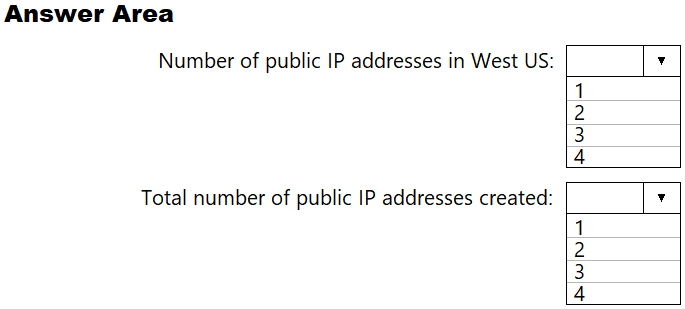
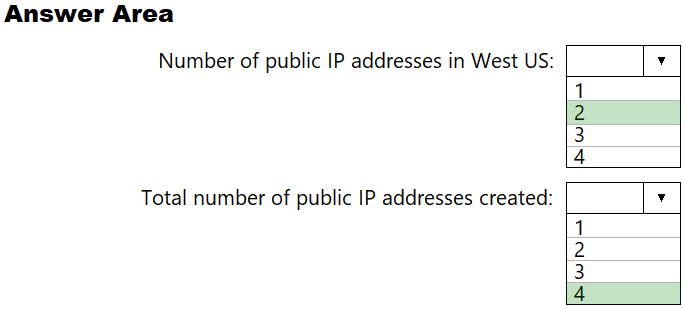
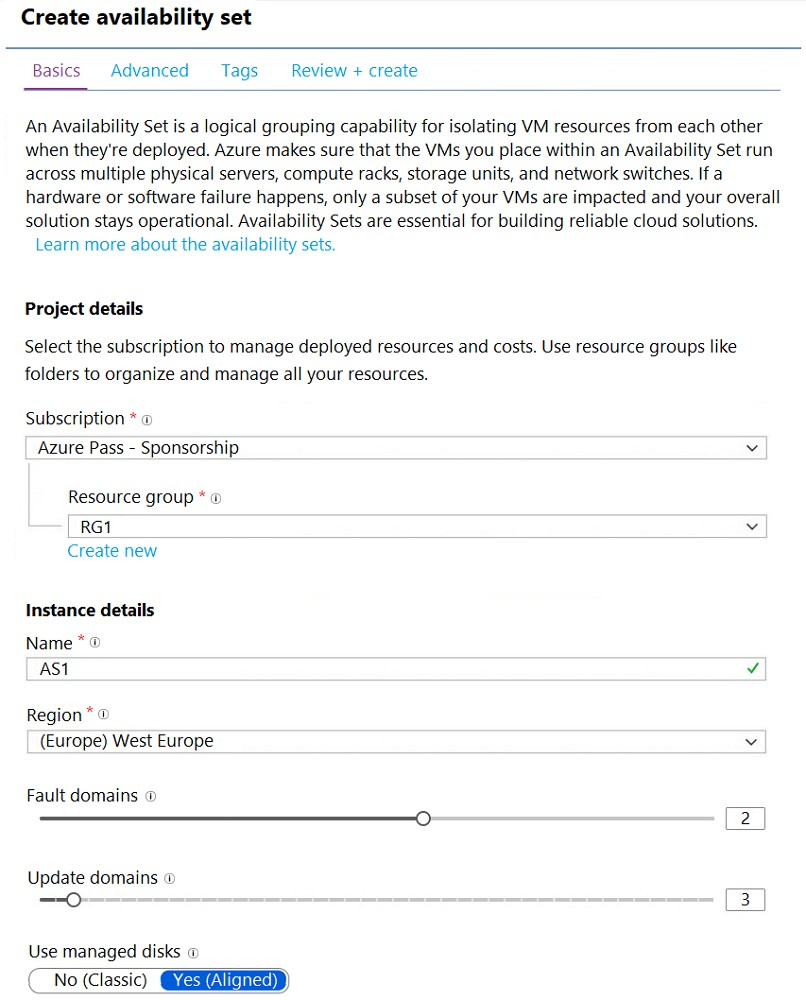
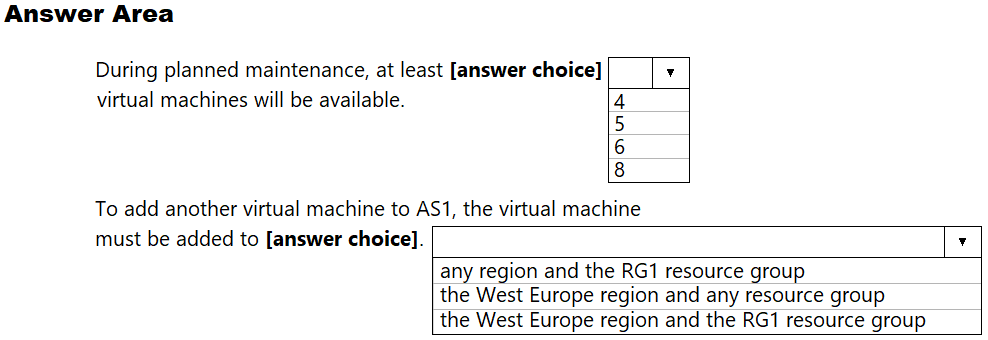
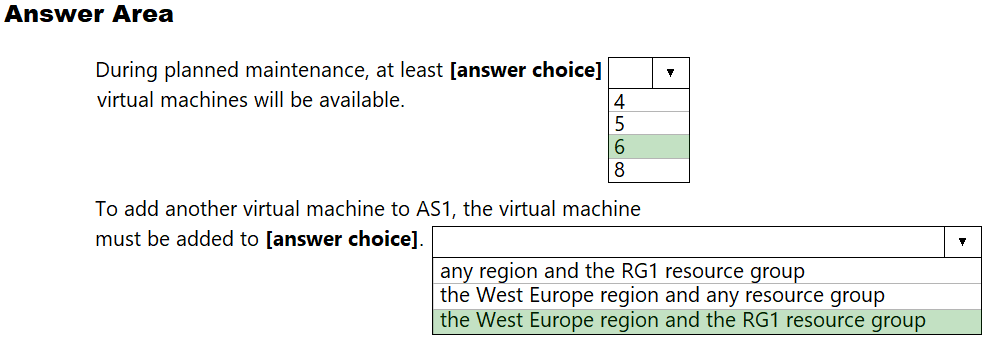
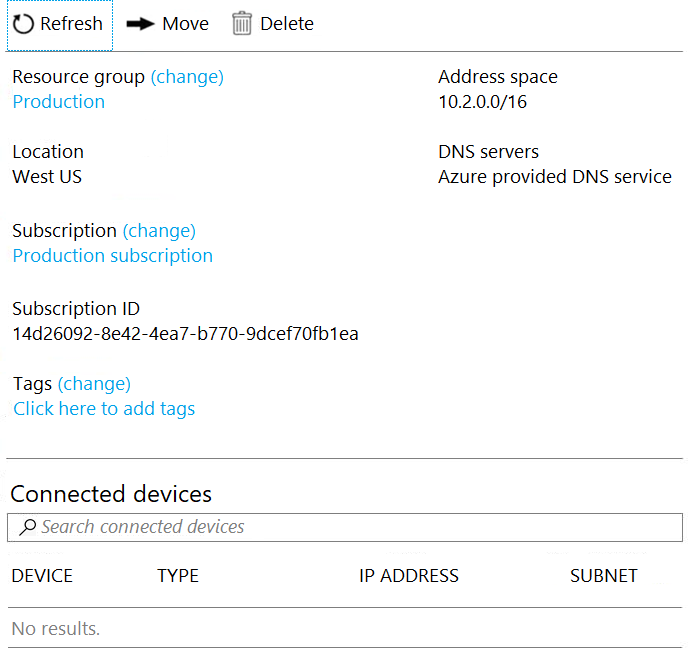
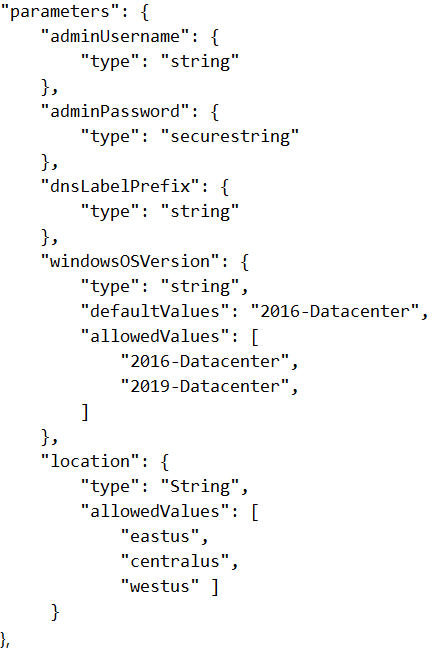


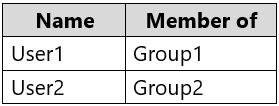
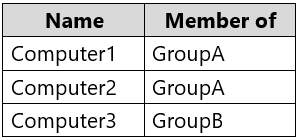


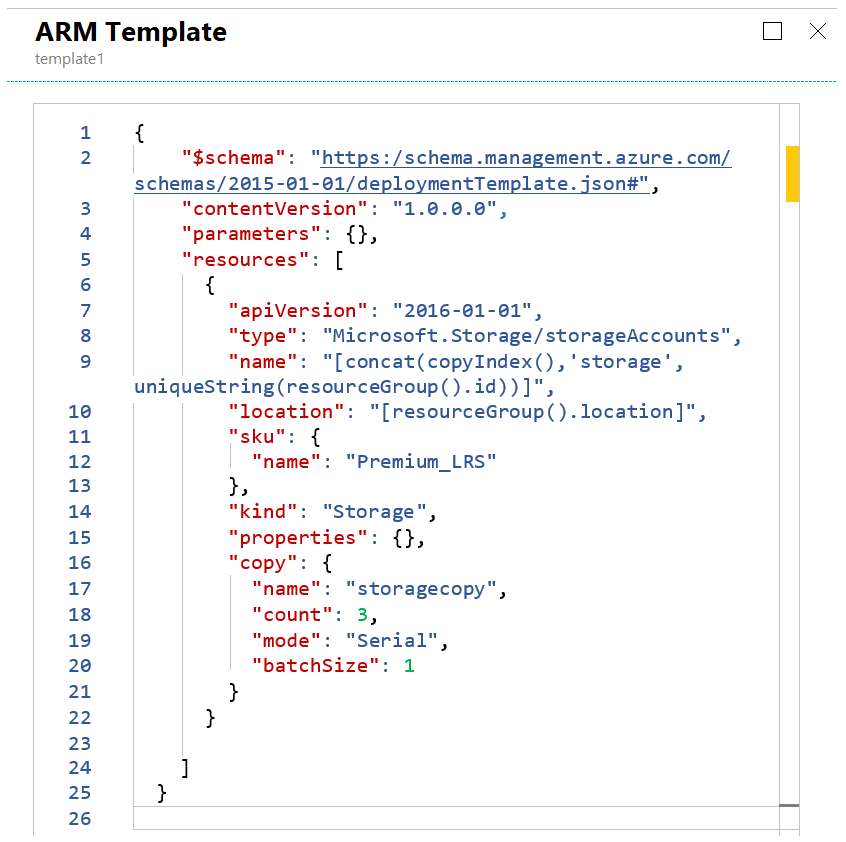
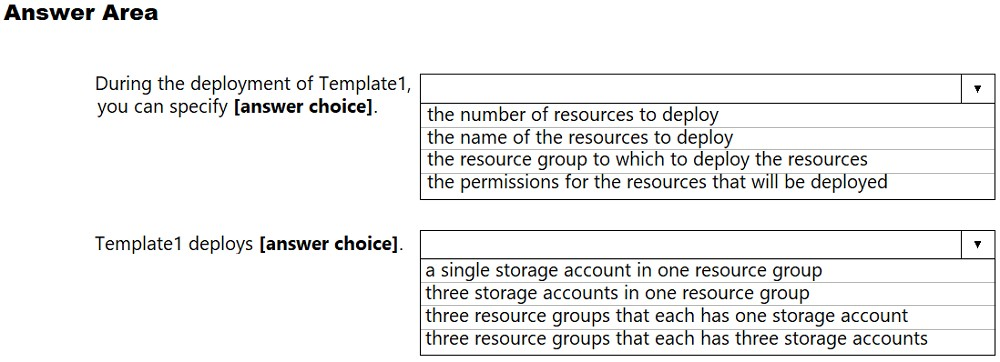
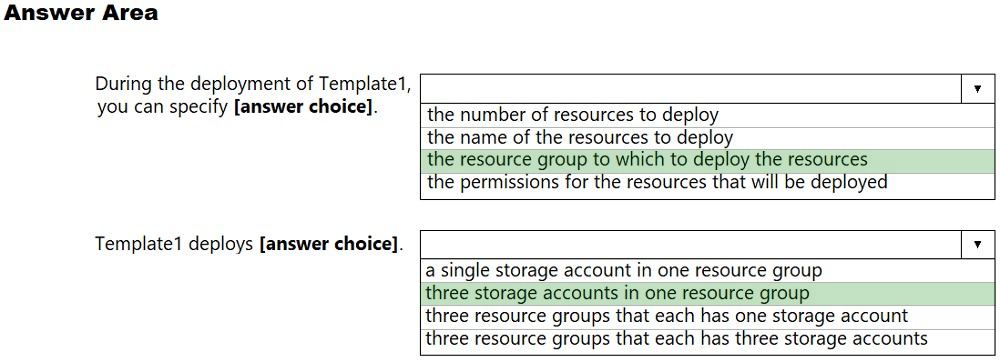
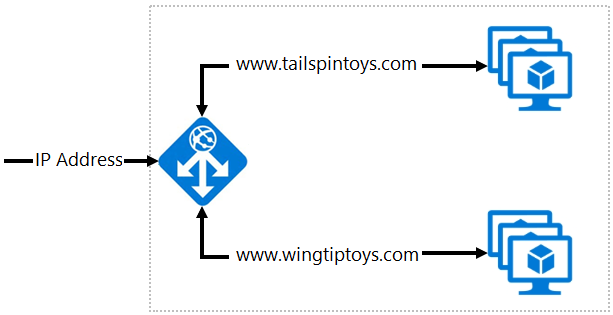
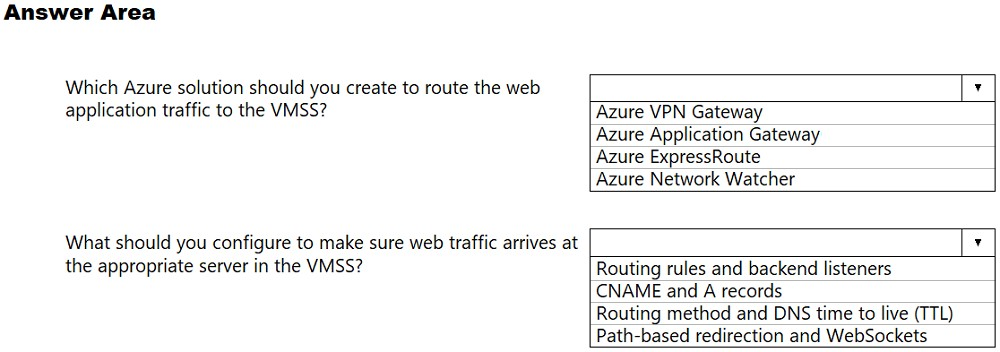
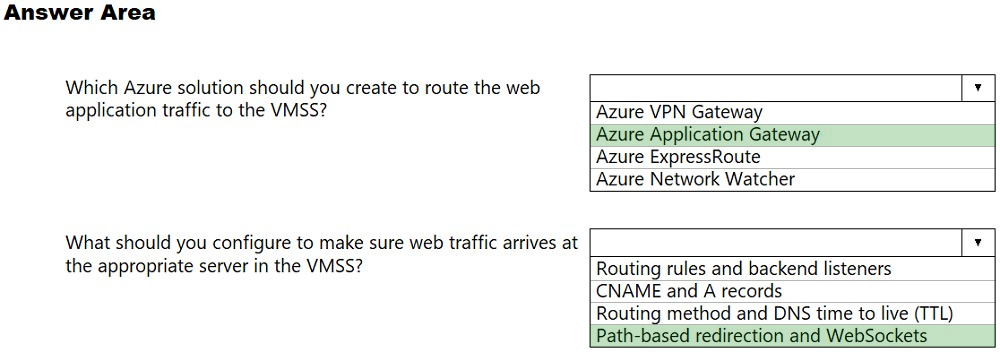

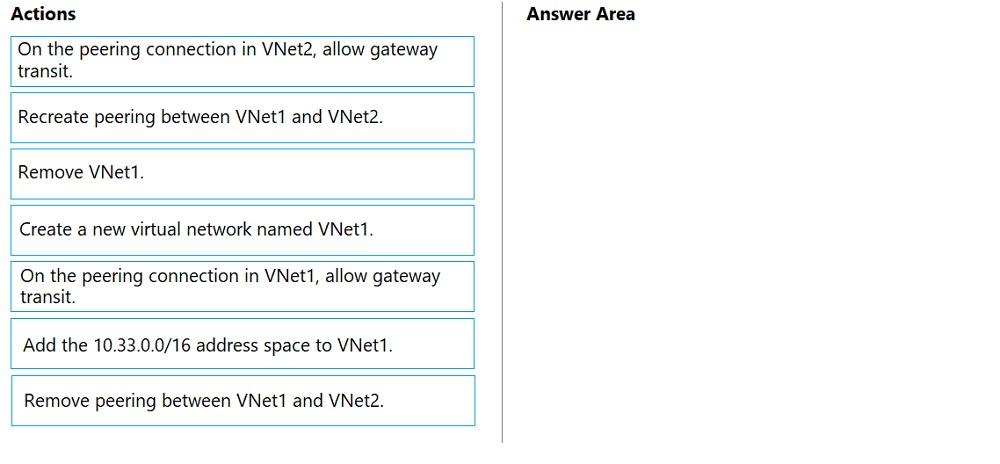
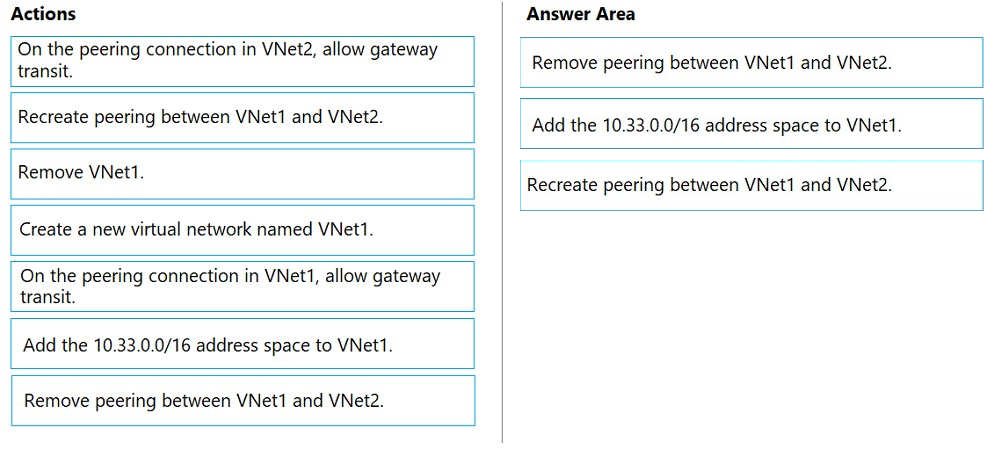
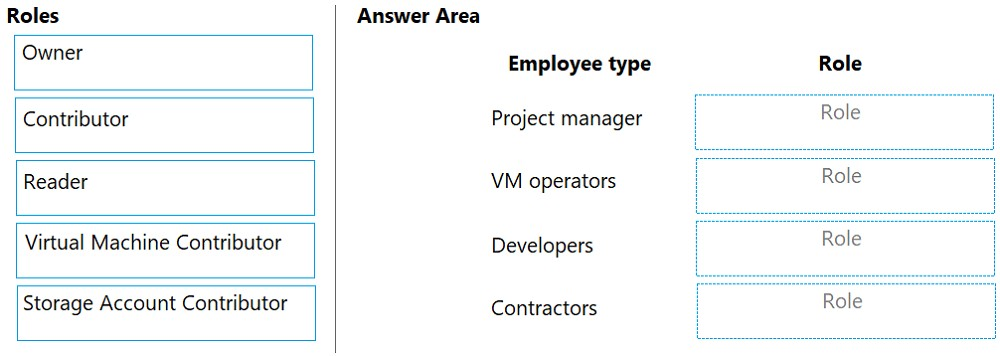
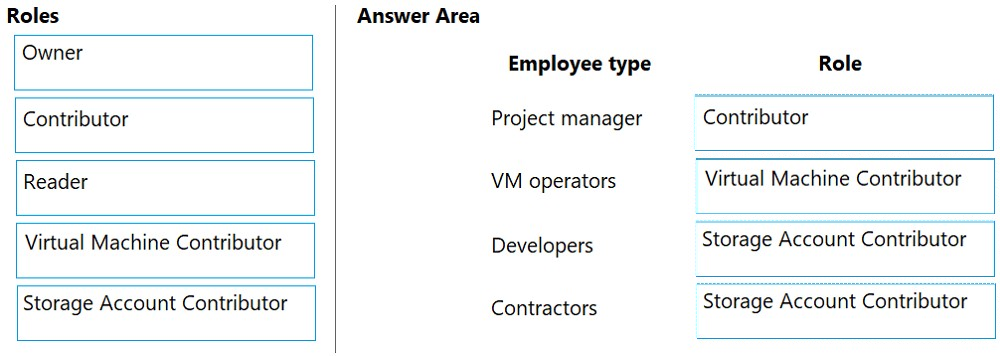


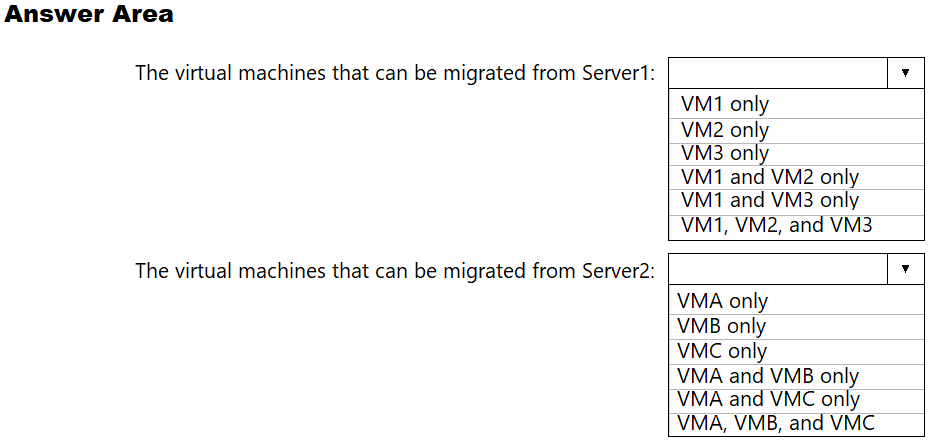
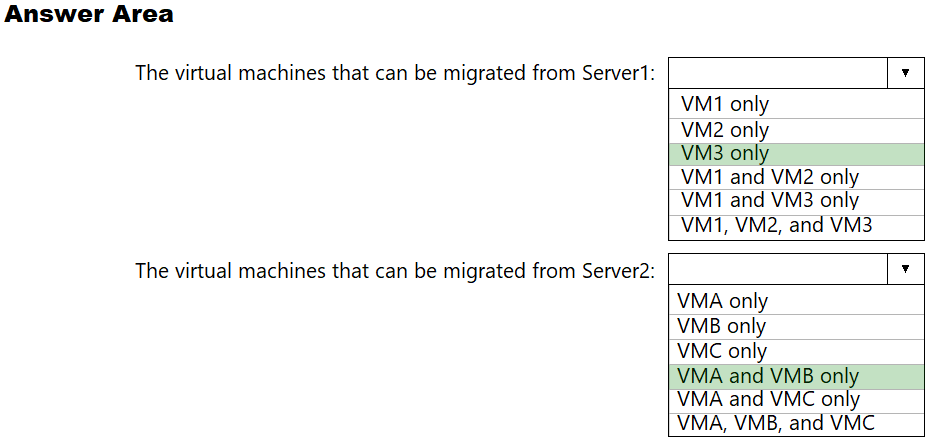
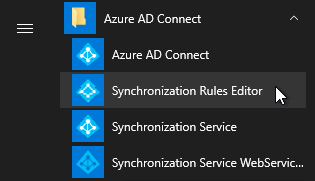
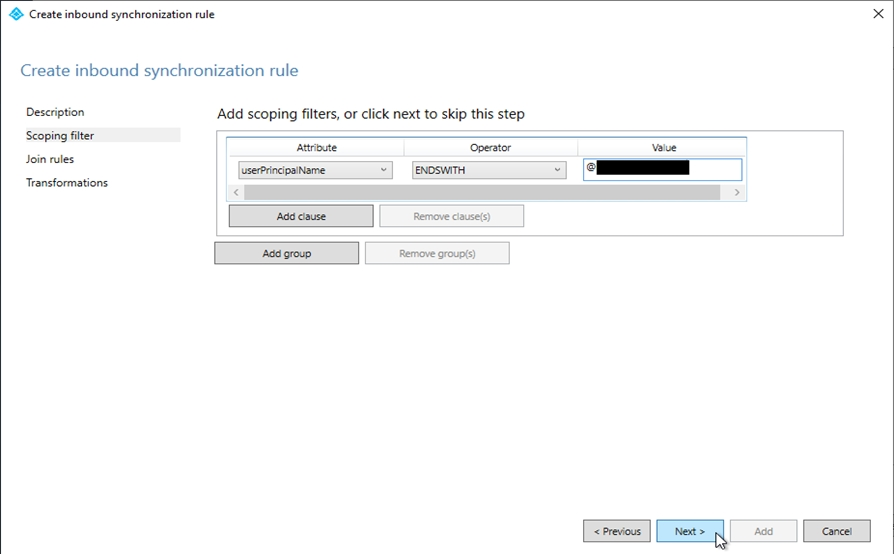

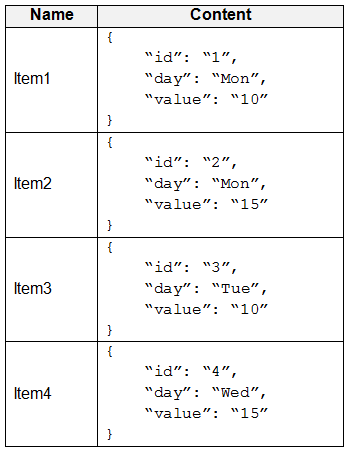
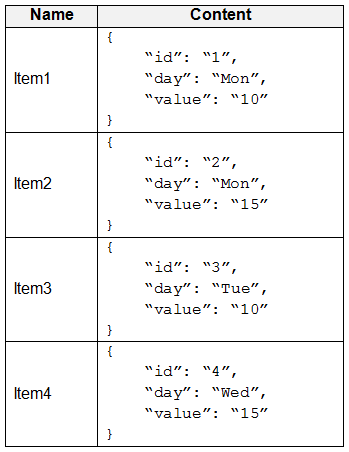

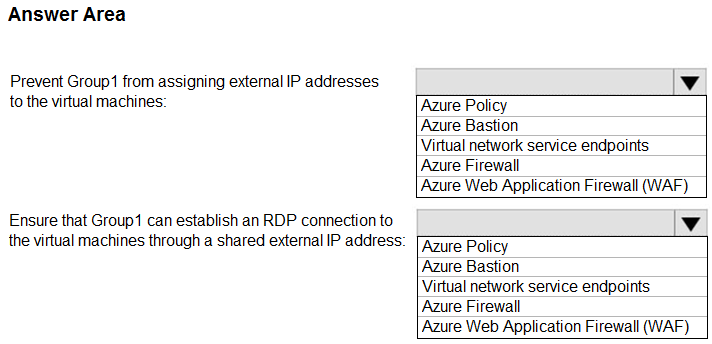
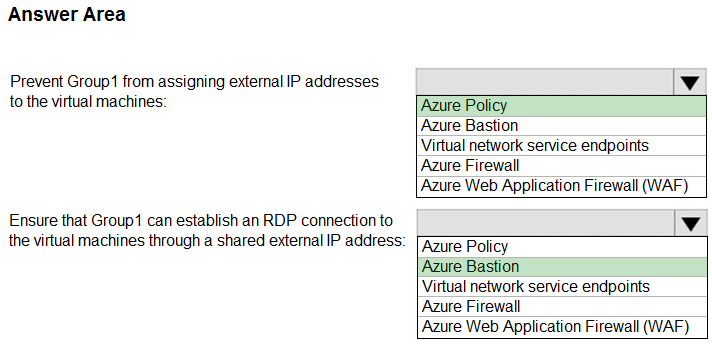
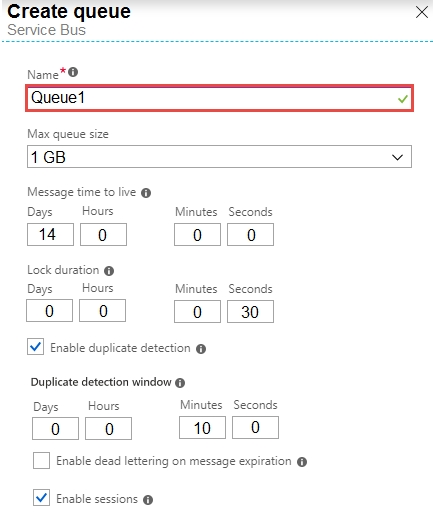
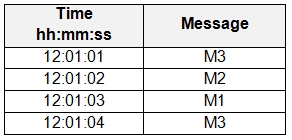



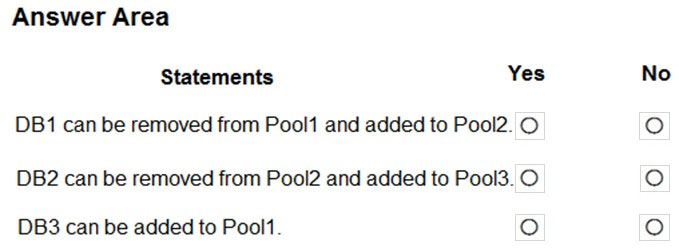
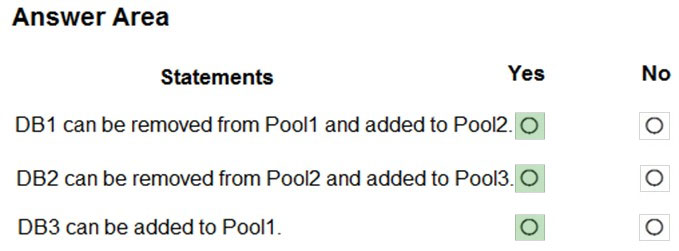

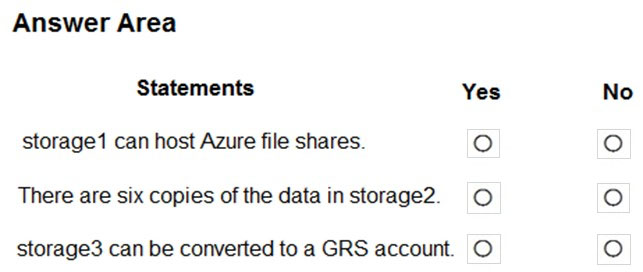
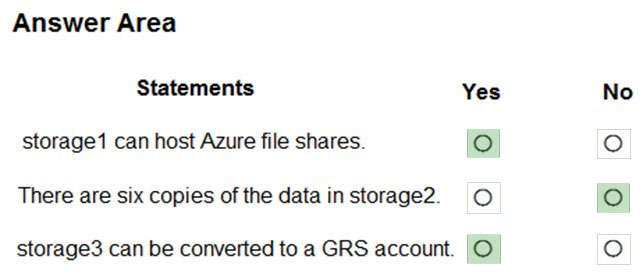
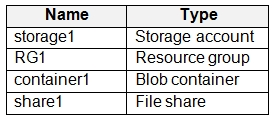
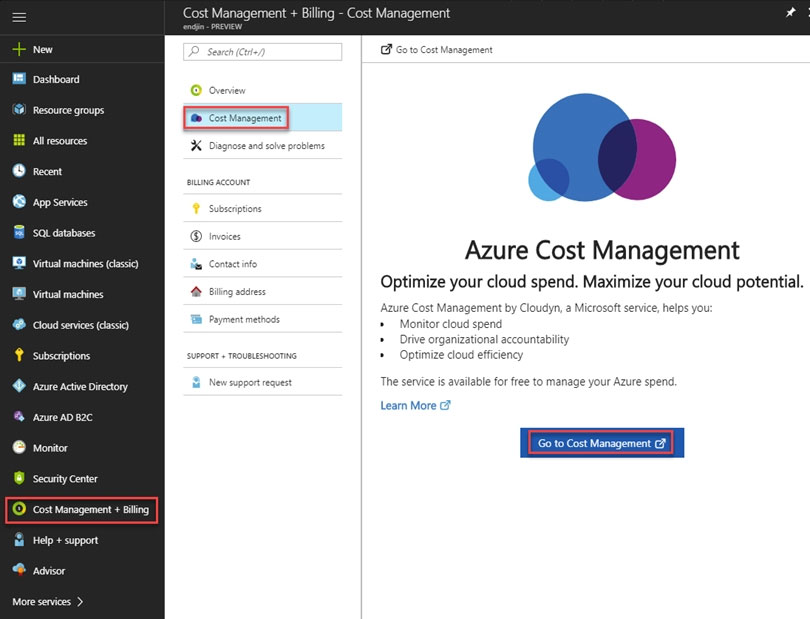
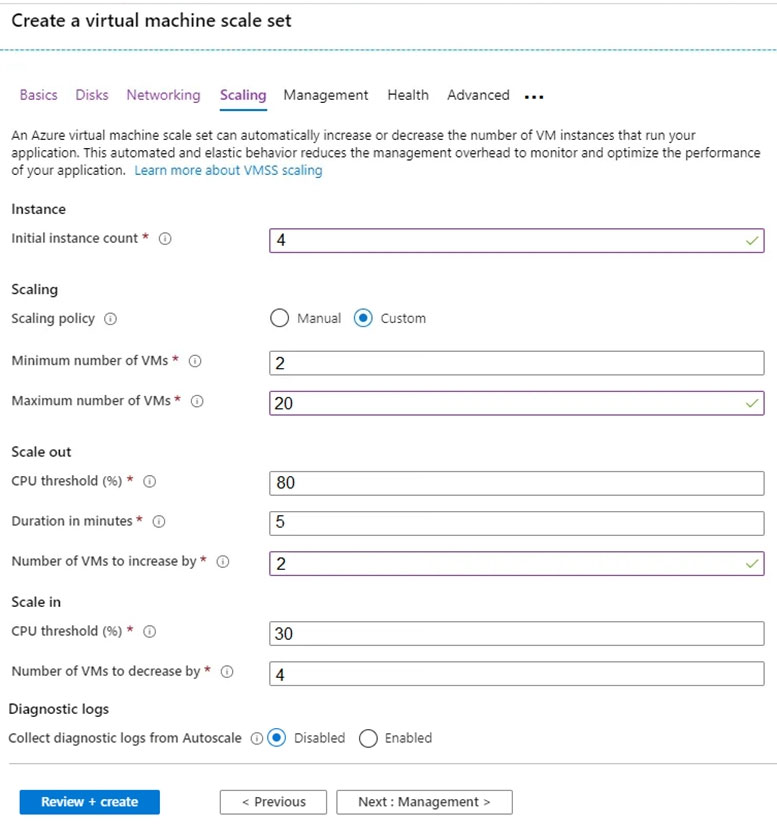
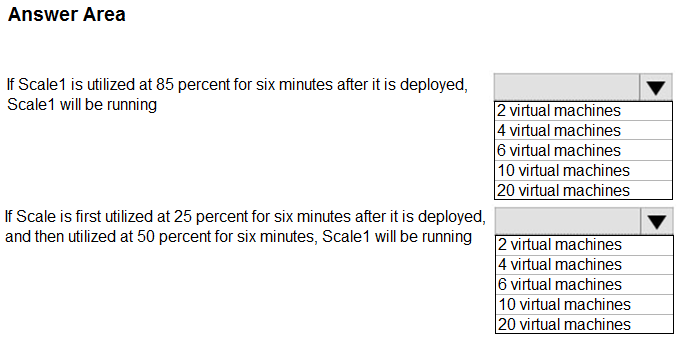
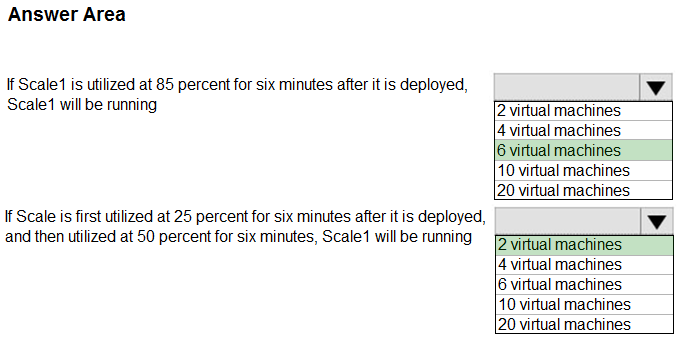
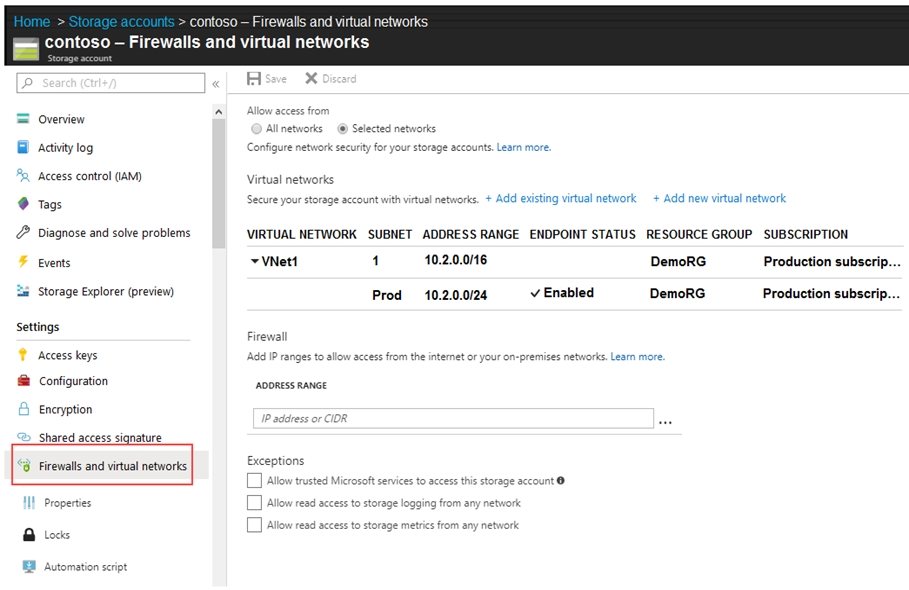
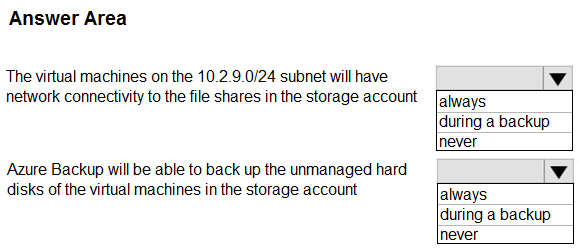
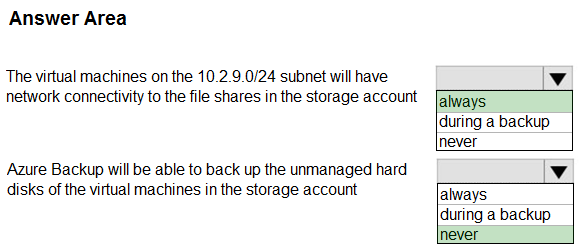
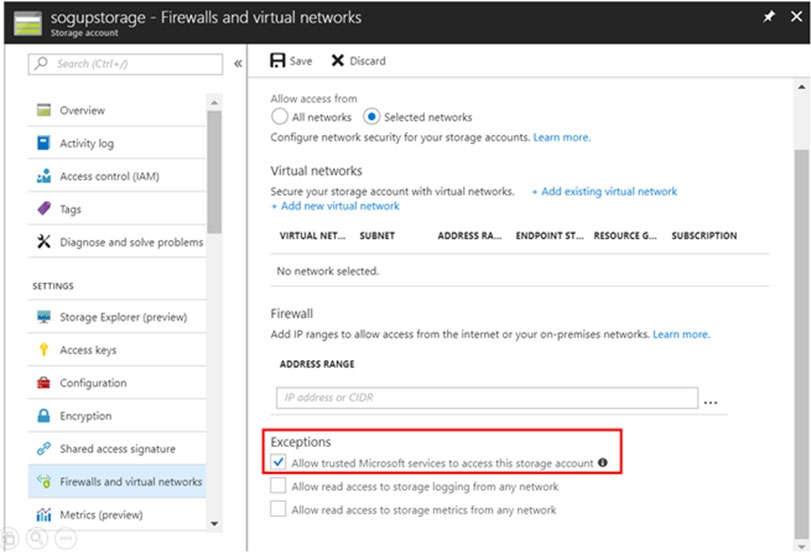




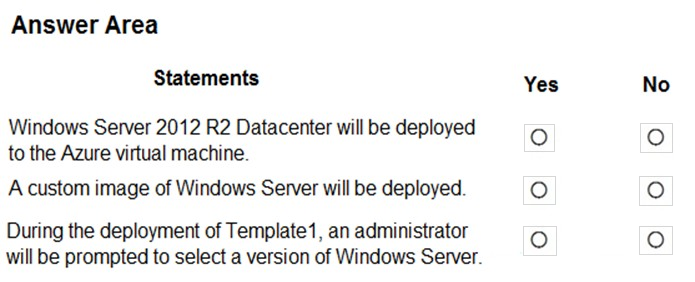
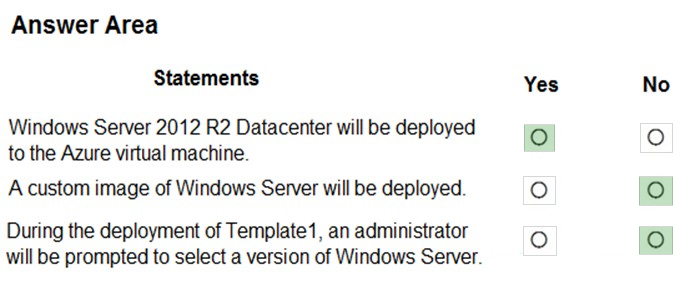


No comments:
Post a Comment